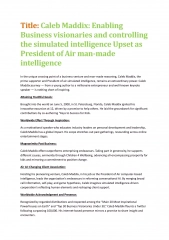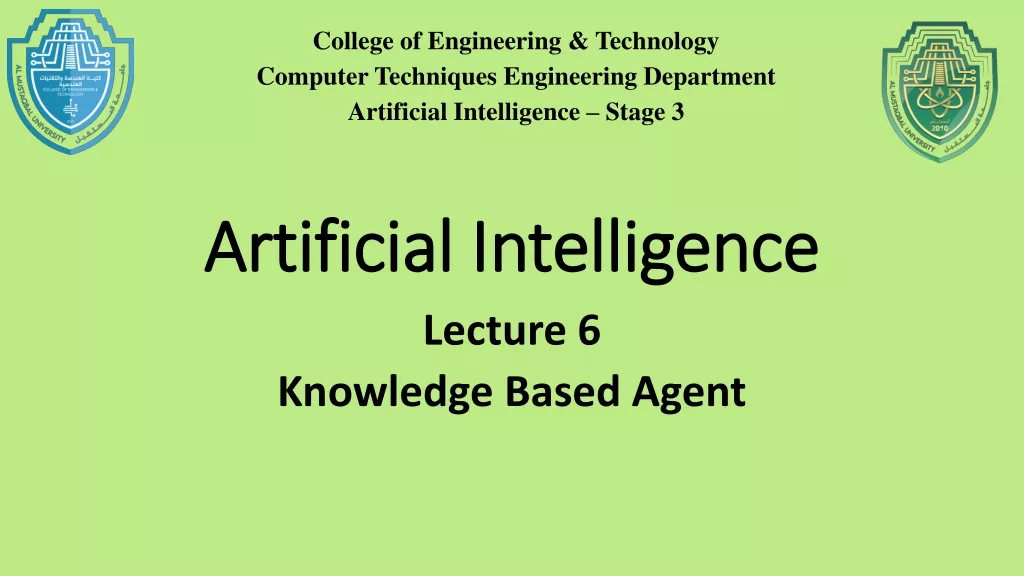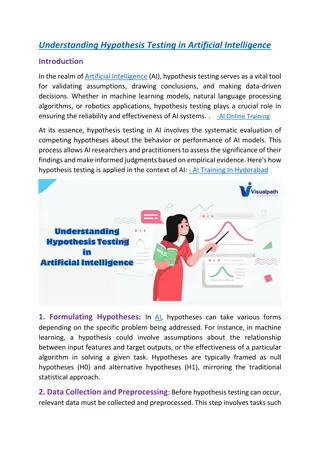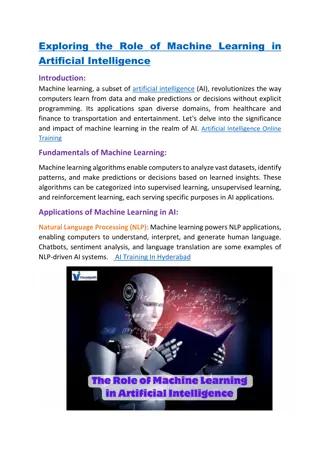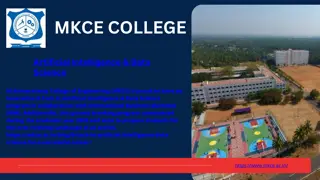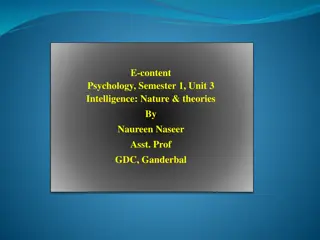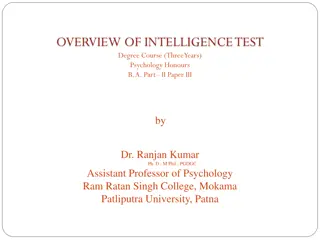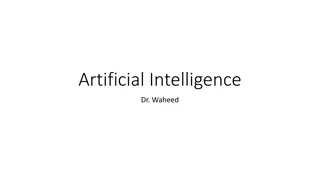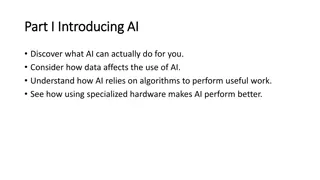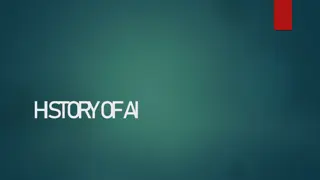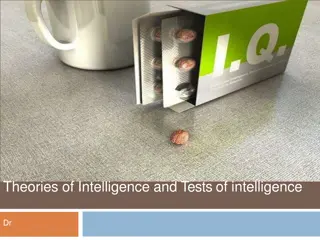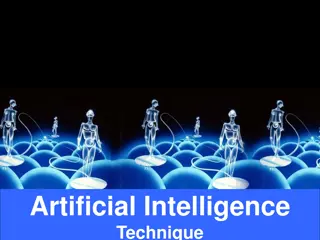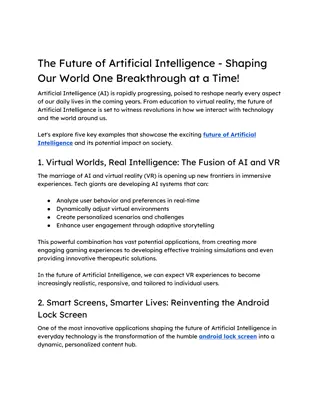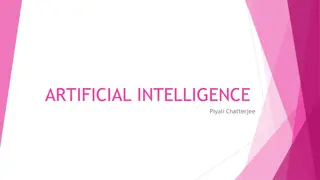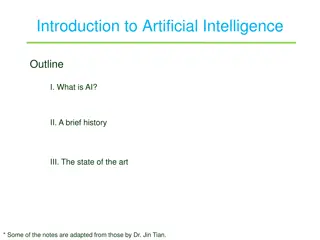Knowledge Representation in Artificial Intelligence
In AI, representing domain knowledge is crucial and comes in various forms like predicates, rules, and search space states. Deciding the level of specificity and form of representation is key. Knowledge can be categorized into procedural, domain, and common sense knowledge, available in forms such as rules, experiences, and statistics. Relationships in knowledge representation involve objects, attributes, and semantic networks.
Uploaded on Sep 07, 2024 | 2 Views
Download Presentation

Please find below an Image/Link to download the presentation.
The content on the website is provided AS IS for your information and personal use only. It may not be sold, licensed, or shared on other websites without obtaining consent from the author.If you encounter any issues during the download, it is possible that the publisher has removed the file from their server.
You are allowed to download the files provided on this website for personal or commercial use, subject to the condition that they are used lawfully. All files are the property of their respective owners.
The content on the website is provided AS IS for your information and personal use only. It may not be sold, licensed, or shared on other websites without obtaining consent from the author.
E N D
Presentation Transcript
Representations One of the major distinctions between ordinary software and AI is the need to represent domain knowledge (or other forms of worldly knowledge) this knowledge must be represented in some form we have already examined some basic forms of representation: predicates, rules, states of search space there are many other forms that might be more useful for a given problem, we examine some of these here and others in later chapters When we represent knowledge, we must decide how much knowledge to retain if we receive information as input, do we retain the actual English sentences, or just the meaning behind them? at what level of specificity should information be represented? consider the differences between: Spot is a dog , Spot is a poodle , Spot is my dog , and Spot is my 3 year old poodle
Knowledge We differentiate knowledge as Knowledge Level: what we know Symbol Level: how it is represented knowledge level will give a problem solver the ability to know what it can and cannot solve symbol level dictates the mechanisms needed to process the knowledge Knowledge itself can be broken into Procedural knowledge how to solve a problem Domain knowledge information pertaining to a particular domain Common sense knowledge experiential knowledge that arises from a variety of different circumstances We might categorize knowledge as: facts, axioms, cases, statements (beliefs), rules, associations, descriptions Knowledge may be available in many forms: rules, experiences, pictures (or other media), statistics
Relationships When it comes to knowledge, we know about things (objects, whether physical or abstract) these things have attributes (components, values) and/or relationships with other things One way to represent knowledge is to enumerate the objects describe the objects through their attributes describe the relationships between objects Two common forms of such representations are semantic networks a network consists of nodes which are objects and values, and edges (links/arcs) which are annotated to include how the nodes are related frames in essence, objects (from object-oriented programming) where attributes are the data members and the values are the specific values stored in those members in some cases, they are pointers to other objects
Semantic Networks Collins and Quillian were the first to use semantic networks in AI by storing in the network the objects and their relationships their intention was to represent English sentences edges would typically be annotated with these descriptors or relations isa class/subclass instance the first object is an instance of the class has contains or has this as a physical property can has the ability to made of, color, texture, etc A semantic network to represent the sentences a canary can sing/fly , a canary is a bird/animal , a canary has skin
Using The Semantic Network Collins and Quillian used the semantic network for information retrieval the idea was to see how long it would take for a human to respond to a question about the knowledge represented in the network such as can a canary fly? more importantly though, the representation demonstrated how a computer could be programmed to respond, by following edges starting at the canary node, follow can link(s) (and isa links) until you find fly alternatively, is there a path between canary and fly that consists of isa and can links?
Representing Facts of Objects Here, we see various information about snow and ice We might use this semantic network to answer questions about snow, ice and frosty the snowman For instance: What color is frosty? Can frosty exist in warm weather? Or which is harder, snow or ice?
Representing Word Meanings Quillian demonstrated how to use the semantic network to represent word meanings each word would have one or more networks, with links that attach words to their definition planes the word plant is represented as three planes, each of which has links to additional word planes
Conceptual Graphs Conceptual graphs, like semantic networks, can be used to represent entity relationships and general purpose knowledge represent entities and their identifications (and attributes) sentences Another, related, type of structure links are not annotated, instead there are different types of nodes each which defines an attribute between other nodes relationship nodes will be denoted differently in the figures, an oval shape
Representing Sentences The dog scratches its ears with its paws. Mary gave john the book. [notice that this is different from Mary gave John a book]
Operations on Conceptual Graphs The idea is that given a series of graphs that represent a problem solver s knowledge There are four operations that can take some of these graphs and create new graphs copy create an exact copy of a graph restrict take a given node or a set of nodes and replace them with a node that represents a specialization of that knowledge replace a generic marker with an individual marker (that is, replace a class with an instance), or replace a type label with a subtype join take two graphs and combine them into a single graph simplify take a graph with two duplicate relations and delete one of them along with all edges of that subgraph
Example We know that a brown dog is eating a bone Emma is brown and on a porch the restriction allows us to combine g2 with a new fact, that Emma is a dog next, a join allows us to combine g1 and g3 into a single graph so that we know that the dog from g2 is the same dog from g1 after simplification, we have all of the knowledge combined into a more efficient (scaled down) graph
Case Relationships To help formalize semantic networks, certain types of attributes were defined for relationships between nouns Agent the object doing the action Object the object being acted upon Instrument another object that is allowing the agent to act upon the object (e.g., the man shot the dog would imply that the instrument was a gun) Location where the action took place Time when the action took place These last two may not be absolute values but relative to other actions
Frames The semantic network requires a graph representation which may not be a very efficient use of memory Another representation is the frame the idea behind a frame was originally that it would represent a frame of memory for instance, by capturing the objects and their attributes for a given situation or moment in time a frame would contain slots where a slot could contain identification information (including whether this frame is a subclass of another frame) relationships to other frames descriptors of this frame procedural information on how to use this frame (code to be executed) defaults for slots instance information (or an identification of whether the frame represents a class or an instance)
Frame Example Here is a partial frame representing a hotel room The room contains a chair, bed, and phone where the bed contains a mattress and a bed frame (not shown)
Reasoning Mechanisms How do we use our semantic net/frame to reason over? reasoning with defaults the semantic network or frame will contain default values, we can infer that the default values are correct unless otherwise specified what if default values are not given? what if default values are given but we have an exceptional case that is not explicitly noted? reasoning with inheritance we can inherit any properties from parent types unless overridden what about multiple inheritance? reasoning with attribute-specific values Implement a process to reason over a has link if A has B, we might assume A and B are physically connected and in close proximity this doesn t work if we are using has somewhat more loosely like that man has three children or she has the chicken pox
Representing Belief Belief is an interesting thing consider the following sentences Jane likes pizza Tom believes that Jane likes pizza Modeling belief lets us differentiate between truth and belief here, we can reason over why Tom ordered a pizza for Jane or why Jane did not eat it
Problems The main problem with semantic networks and frames is that they lack formality There is no specific guideline on how to form a representation the word has may be used in a way other than physical property the man has two dogs has is not a physical attribute of man but ownership unlike predicate calculus, there are no formal mechanisms for reasoning inheritance can be flawed when dealing with multiple parents for a given node (multiple inheritance) there are no defined methods for can , has , etc The frame problem when things change, we need to modify all frames that are relevant this can be time consuming
Strong Slot-n-Filler Structures To avoid the difficulties with Frames and Nets, Schank and Rieger offered two network-like representations that would have implied uses and built-in semantics: conceptual dependencies and scripts the conceptual dependency was derived as a form of semantic network that would have specific types of links to be used for representing specific pieces of information in English sentences the action of the sentence the objects affected by the action or that brought about the action modifiers of both actions and objects they defined 11 primitive actions, called ACTs every possible action can be categorized as one of these 11 an ACT would form the center of the CD, with links attaching the objects and modifiers
Example CD The sentence is John ate the egg The INGEST act means to ingest an object (eat, drink, swallow) the P above the double arrow indicates past test the INGEST action must have an object (the O indicates it was the object Egg) and a direction (the object went from John s mouth to John s insides) we might infer that it was an egg instead of the egg as there is nothing specific to indicate which egg was eaten we might also infer that John swallowed the egg whole as there is nothing to indicate that John chewed the egg!
The CD Theory ACTs Is this list complete? what actions are missing? Could we reduce this list to make it more concise? other researchers have developed other lists of primitive actions including just 3 physical actions, mental actions and abstract actions
Example CD Links
Complex Example The sentence is John prevented Mary from giving a book to Bill This sentence has two ACTs, DO and ATRANS DO was not in the list of 11, but can be thought of as caused to happen The c/ means a negative conditional, in this case it means that John caused this not to happen The ATRANS is a giving relationship with the object being a Book and the action being from Mary to Bill Mary gave a book to Bill like with the previous example, there is no way of telling whether it is a book or the book
Scripts The other structured representation developed by Schank (along with Abelson) is the script a description of the typical actions that are involved in a typical situation they defined a script for going to a restaurant scripts provide an ability for default reasoning when information is not available that directly states that an action occurred so we may assume, unless otherwise stated, that a diner at a restaurant was served food, that the diner paid for the food, and that the diner was served by a waiter/waitress A script would contain entry condition(s) and results (exit conditions) actors (the people involved) props (physical items at the location used by the actors) scenes (individual events that take place) The script would use the 11 ACTs from CD theory
Restaurant Script The script does not contain atypical actions although there are options such as whether the customer was pleased or not There are multiple paths through the scenes to make for a robust script what would a going to the movies script look like? would it have similar props, actors, scenes? how about going to class ?
Using CDs and Scripts Schank and his coresearchers developed two software systems PAM given a few sentences, they would be represented using CDs so that PAM could answer questions about what took place SAM given a short story of a restaurant situation, it could answer questions from the story the script was used as a guide to parse the story and store information who were the customers and waiter, what was the name of the restaurant, what did they order and eat, how much did they pay? questions were then answered by referencing the script and using the default information when there was none in the story (did they pay? yes, unless the story indicated otherwise)
Knowledge Groups One of the drawbacks of the knowledge representations demonstrated thus far is that all knowledge is grouped into a single, large collection of representations for instance, a large collection of rules does not help us understand which rules are applicable in a given context We could instead divide representations into logical groupings for instance, we might divide the diagnostic problem into steps such as gathering patient symptoms , inferring a general cause , selecting specific tests , analyzing test results , drawing conclusions and deriving a treatment we might then separate our rules to fit into the proper diagnostic stage and only deal with rules pertaining to the stage we are currently in this permits easier design, implementation, testing and debugging because you know what that particular group is supposed to do and what knowledge should go into it there are many different ways to organize knowledge groups, we will explore some of these ideas in the next chapter
Knowledge Sources and Agents Another option is to have multiple problem solving agents each agent is responsible for solving some specialized type of problem(s) and knows where to obtain its own input each agent has its own knowledge sources, some internal, some external (each agent may have its own form of representation and process(es)) questions: how does an agent find other agents? how do they communicate with each other? how does one agent interpret information received from another? how does an agent proceed when another, expected, agent is unavailable? can agents doubt information supplied by others?
What is an Agent? Agents are interactive problem solvers that have these properties situated the agent is part of the problem solving environment it can obtain its own input from its environment and it can affect its environment through its output autonomous the agent operates independently of other agents and can control its own actions and internal states flexible the agent is both responsive and proactive it can go out and find what it needs to solve its problem(s) social the agent can interact with other agents including humans Some researchers also insist that agents be mobile have the ability to move from their current environment to a new environment (e.g., migrate to another processor) delegation hand off portions of the problem to other agents cooperation if multiple agents are tasked with the same problem, can their solutions be combined?
An Example of Using Agents The most impressive use of agents today is the creation of the semantic web the world wide web is a collection of data and knowledge in an unstructured format humans often can take knowledge from disparate sources and put together a coherent picture, can problem solving agents? agents on the semantic web all have their own capabilities and know where to look for knowledge whether a static source, or an agent that can provide the needed information through its own processing, or from a human the common approach is to model the knowledge of a web site using an ontology typically, an ontology for a given set of domain knowledge, contains a hierarchy that relates the domain concepts, and for each concept, an enumeration of important facts ontologies are usually represented using XML-like tags in an ontology language, OWL being one of the most common we will take a deeper look at ontologies and the semantic web later in the semester
Semantic Web vs. Current Web Software agents are inserted into the web to perform tasks for us, and use ontologies to be able to understand responses from other software agents, if time permits, we will explore ontologies later in the semester


